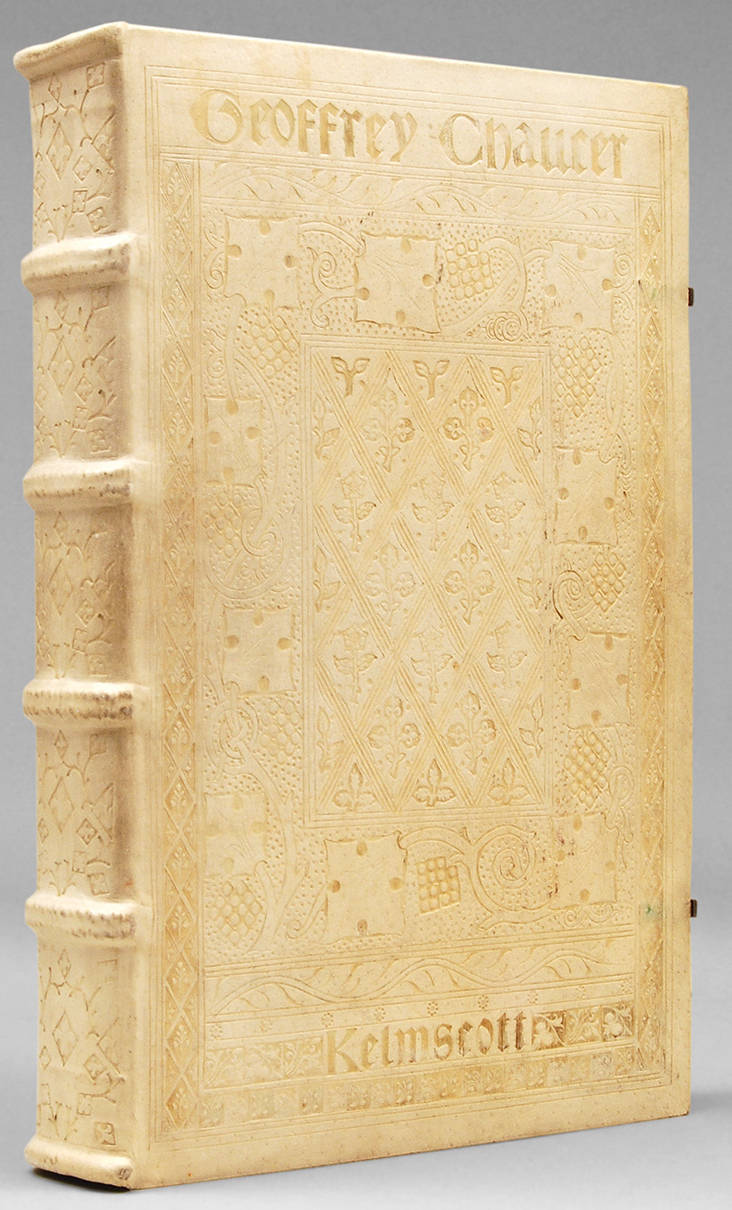

The Works of Geoffrey Chaucer F. S. Ellis, editor. Hammersmith, Kelmscott Press: William Morris. Publisher, 1896. Designer-Illuminator: William Morris. Illustrator: Edward Burne-Jones. Illustrated: Upper white pigskin cover. 43.2 x 29.9 cm. Vellum folio containing the Prologue to The Canterbury Tales. 42.2 x 28 cm. photographs © Peter Harrington. Formatting by George P. Landow. Beckwith, Victorian Bibliomania catalogue no. 35.
Commentary by Alice H. R. H. Beckwith
Six hundred years ago, in 1387, Geoffrey Chaucer began the Prologue to his Canterbury Tales. These stories are connected by the framework of the pilgrims' shared journey to the tomb of Saint Thomas Becket at Canterbury. Along the way stories are told by twenty-one of the thirty pilgrims, which reveal much about life in Britain during the later fourteenth century (Baugh, 228, 234). Chaucer's works, with their descriptive fullness and warm humanity, were a touchstone of British culture in Morris's day, and indeed they remain so today. The Kelmscott Chaucer received more notice than any of the fifty-three other titles from Morris's press; as recently as 1982 Duncan Robinson published a book about the making of the Chaucer. Morris used the Middle English text edited by Oxford Professor W. W. Skeat, since he wanted the most up-to-date and complete version (Needham, 135). The Canterbury Tales comprise less than half of the Kelmscott Works of Geoffrey Chaucer, although they are the best known of Chaucer's writings.

The pages illustrated here are set in Morris's Chaucer type except for the two lines of introduction above the illustration, which arc in upper-case Troy. The Chaucer type is a smaller or pica version of the Troy. Both types are Gothic in inspiration, but greatly simplified and solid in shape when compared with Gothic-influenced printed texts from earlier in the century (cat. 31). Type, borders, initial words and letters, all contribute to the springtime mood Chaucer created in his Prologue. Describing the interaction among the visual elements in architectural terms, Burne-Jones wrote of the Chaucer,
I am making the designs as much to fit the ornament and the printing as they are made to fit the little pictures—& I love to be snugly cased in the borders & buttressed up by the vast initials—& once or twice when I have no big letter under me, I feel tottery & weak; if you should drag me out of my encasings it will be like tearing a statue out of its niche and putting it in a museum . . . when the book is done . . . it will be a little like a pocket cathedral. [Needham, 138]
Burne-Jones wrote this note on December 8, 1894 to John Ruskin's friend and protege of many years, the American art historian Charles Eliot Norton of Harvard University. The "pocket cathedral" reference, pairing architectural and book design, is a mutually understood reference to Ruskin's teachings. In Ruskin's first section of his autobiography, Praeterita (1889), he described his first purchase of an illuminated manuscript, saying, "For truly a well-illuminated missal is a fairy cathedral full of painted windows to carry in one's pocket, with the music and blessing of all its prayers besides" (35.491).
Grapevines support the visual resonance between the white pigskin cover and the border surrounding the text and miniature-like illustration of the Prologue page. Morris designed the binding tools, and the Doves Bindery executed forty-eight of these covers by 1897. Morris's design for the covers shows the creative inspiration he derived from fifteenth-century Germanic bindings: the back cover in particular is related to a volume in Morris's own collection, a Koberger Bible bound by Ulrich Schreier of Salzburg in 1478 (Needham, 140). In his binding designs, as with his typefaces, Morris absorbed historical models and then reinterpreted them for nineteenth-century eyes.
Related Material
- Peter Harrington's commentary
- The British Museum’s The Canterbury Tales (Harley Ms 1758) viewable online (outside the Victorian Web)
References
Beckwith, Alice H. R. H. Victorian Bibliomania: The Illuminated Book in Nineteenth-Century Britain. Exhibition catalogue. Providence. Rhode Island: Museum of Art, Rhode Island School of Design, 1987.
The Works of Geoffrey Chaucer now newly imprinted. Hammersmith: The Kelmscott Press, 1896. the 1987 exhibition included the Pierpont Morgan Library's bound copy and a vellum folio, Koopman Specimen Collection, John Hay Library, Brown University. The Pierpont Morgan copy, which belonged to Junius Morgan, is dated 1898 and is one of an undetermined number of these bindings produced at the Doves Bindery after 1897 (Needham, 140).
Last modified 27 February 2016